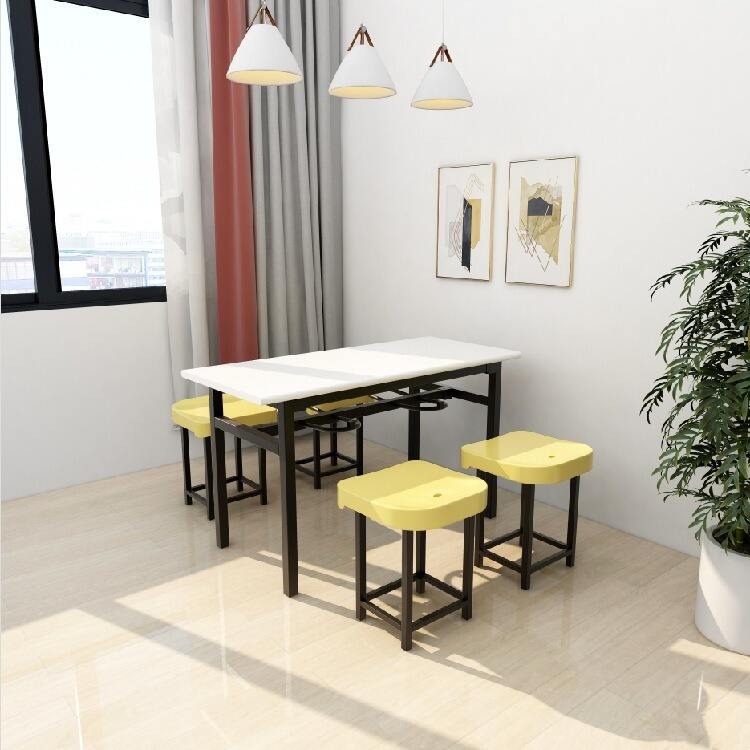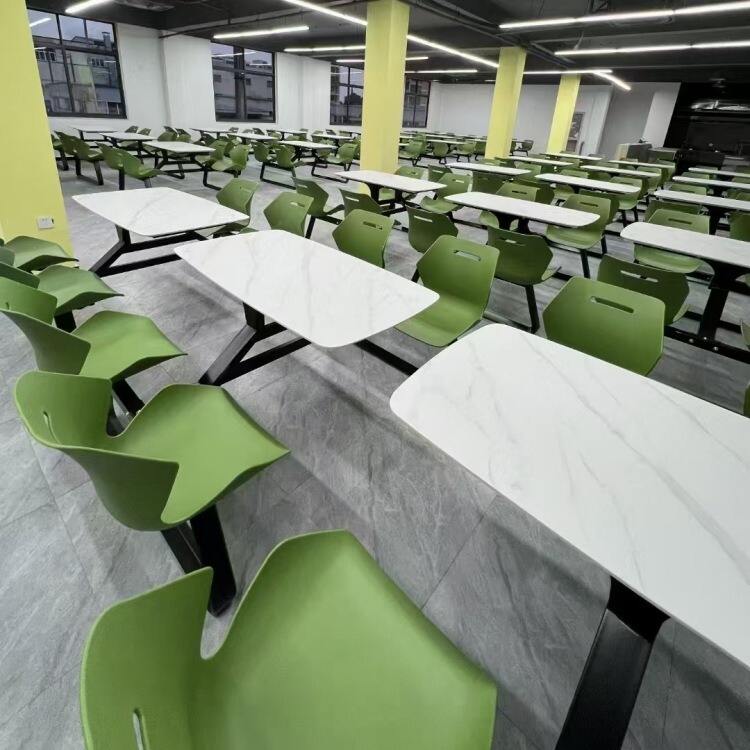စားသောက်ဆိုင်များတွင် စားပွဲနှင့် ကုန်းများသည် စားသောက်ဆိုင်၏ စုစည်းမှုနှင့် ပတ်ဝန်းကျင်အား မည်သို့မျှ ပံ့ပိုးပေးနိုင်မည်နည်း
စားသောက်ဆိုင်များတွင် အသုံးပြုသည့် အဆောက်အဦများ၏ အခန်းကဏ္ဍကို မိတ်ဆက်ခြင်း
လူတို့သည် စားသောက်ဆိုင်ကို တွေးတော့်တိုင်း ပထမဆုံး စိတ်ကူးထဲတွင် ပေါ်လာတတ်သည့် ပုံရိပ်များမှာ စားစရာစာရင်း၊ အစားအစာများနှင့် ဝန်ဆောင်မှုတို့ဖြစ်ပါသည်။ သို့ရာတွင် စားသောက်ဆိုင်၏ ပတ်ဝန်းကျင်သည် ဖောက်သည်များ၏ အတွေ့အကြုံကို ပုံဖော်ရာတွင် အတူတူပင် သက်ရောက်မှုရှိပါသည်။ စီစဉ်မှု၊ ဒီဇိုင်းနှင့် အဆောက်အဦ၏ ပုံစံများ—အထူးသဖြင့် စားသောက်ဆိုင် စားပွဲနဲ့ ခုံ — အားလုံးသည် နေရာ၏ သဘောတရားနှင့် အတွင်းပိုင်းကို တည်ဆောက်ရာတွင် အဓိက အခန်းကဏ္ဍမှ ပါဝင်ပါသည်။ ထိုသို့သော အစိတ်အပိုင်းများသည် ထိုင်ခုံများကိုသာ ပေးစွမ်းခြင်းထက် ပိုမိုသော အဓိပ္ပာယ်ရှိပြီး စားသောက်ဆိုင်၏ စိတ်နှလုံးကို ကိုယ်စားပြုပါသည်။ အမှတ်တရားကို ဖော်ပြပါသည်။ အစာစားခြင်းအတွေ့အကြုံ၏ သဘောတရားကို သက်ရောက်စေပါသည်။ စားပွဲနှင့် ခုံများကို ဂရုတစိုက် ရွေးချယ်ပေးထားခြင်းဖြင့် ရိုးရှင်းသော အခန်းကို အဆင့်မြင့်စားသောက်ဆိုင်၊ ရိုးရာဘစ်ထုရို၊ ပူဇော်စရာကောင်းသော ကော်ဖီဆိုင် သို့မဟုတ် စွမ်းအင်ပြည့်ဝသော မြန်စွာစားသောက်နိုင်သည့်နေရာတို့အဖြစ်သို့ ပြောင်းလဲပေးနိုင်ပါသည်။
အသုံးအဆောင်များနှင့် စားသောက်ဆိုင်၏ အတွင်းသဘော ဆက်နွယ်မှု
စားပွဲနှင့် ခုံများသည် ဇာတ်လမ်းပြောပြသူများအဖြစ်
အစားအသောက်ဆိုင်တိုင်းတွင် ဇာတ်လမ်းတစ်ပုဒ်စီရှိပါသည်။ ယဉ်ကျေးမှုအမွေအနှစ်၊ အစားအစာဆိုင်ရာ ဒဿနိကဗောဓိ သို့မဟုတ် ဘဝအမူအကျင့်များကို အခြေခံ၍ ဖြစ်စေပါစေ။ ဇာတ်လမ်းကို ပိုမိုပြည့်စုံစေရန် စားပွဲနှင့် ကုန်းကျင်းများရွေးချယ်မှုက ကူညီပေးပါသည်။ အစားအသောက်ဆိုင်သည် ရိုးရာအီတလီအစားအစာများကို အထူးတလည်လုပ်ကိုင်ပါက တောက်ပသော သစ်သားစားပွဲများနှင့် ရိုးရာပုံစံမြင့်သော ကုန်းကျင်းများကို ရွေးချယ်နိုင်ပါသည်။ ထို့နည်းတူ အေးခဲသော စူရှိုင်းဘာများသည် အနိမ့်ပုံစံများဖြစ်သော ဂလက်စ်စားပွဲများနှင့် ခေတ်မီသော ကုန်းကျင်းများကို အသုံးပြုနိုင်ပါသည်။ ဤဒီဇိုင်းဆိုင်ရာ ဆုံးဖြတ်ချက်များသည် အစားအသောက်ကို မစားသောက်မီပင် ဖောက်သည်များကို အဆိုပါအစားအသောက်ဆိုင်ကို မည်သို့မြင်စေချင်သည်ကို ပုံဖော်ပေးပါသည်။
အယူအဆနှင့် ဒီဇိုင်းအတွက် တစ်ပုံတည်းဖြစ်မှု
စားသောက်ဆိုင်၏ သဘောတရားနှင့် အဆောက်အဦများကို ညှိနှိုင်းခြင်းသည် စုစုပေါင်းဒီဇိုင်းတွင် တစ်သေ့တည်းဖြစ်စေရန် သေချာစေသည်။ အလှဆင်မှု၊ မီးရောင်၊ အရောင်များနှင့် အဆောက်အဦများအကြား ညီညာမှုဖန်တီးခြင်းသည် အတွေ့အကြုံကို ဖန်တီးပေးသည်။ ဥပမာအားဖြင့် အနုပညာရှင်များနှင့်ပြည့်နှက်သော ဗီကာတိုရီယန်ခုံများကို အနိမ့်စျေးနှုန်းရှိသော စားသောက်ဆိုင်တွင် အသုံးပြုပါက စားသောက်ဆိုင်အမှတ်တရားကို ဝေဖန်သံသရှိစေနိုင်သည်။ အကယ်၍ စားပွဲနှင့်ခုံများသည် အလှဆင်မှုနှင့် သဘောတရားနှင့် ပေါင်းစပ်နေပါက စားသောက်ဆိုင်သည် စုစည်းမှုရှိပြီး စိတ်ဝင်စားစရာကောင်းသော အတွေ့အကြုံကို ပေးစွမ်းနိုင်သည်။
၏သက်ရောက်မှု စားပွဲနဲ့ ခုံ အတွေ့အကြုံအပေါ်
ဒီဇိုင်းများကို အသုံးပြု၍ လေထုကို သက်ရောက်မှုရှိစေခြင်း
အဆောက်အဦ၏ ပုံစံသည် စားသောက်ဆိုင်၏ လေထုကို တိုက်ရိုက်သက်ရောက်သည်။ ပျော့ပျော့ခုံများနှင့် စားပွဲကြီးများသည် အားလပ်ရက်များတွင် စားသောက်ခြင်းကို တွန်းအားပေးသည်။ အထူးသဖြင့် အဆင့်မြင့်စားသောက်ဆိုင်များ သို့မဟုတ် မိသားစုစားသောက်ဆိုင်များအတွက် အဆင်ပြေသည်။ အမြင့်စားပွဲများနှင့် ဘာခုံများသည် စွာလှုပ်ရှားသော လေထုကိုဖန်တီးသည်။ အားကစားဘာများ သို့မဟုတ် အလွယ်တကူဝင်ရောက်နိုင်သော စားသောက်ဆိုင်များအတွက် အဆင်ပြေသည်။ စားပွဲနှင့်ခုံများကို ရွေးချယ်ခြင်းသည် အသုံးဝင်မှုအရ ရွေးချယ်ခြင်းထက် ပိုမိုပါသည်။ စားသောက်ခြင်းအတွေ့အကြုံ၏ စနစ်ကျမှုနှင့် စွမ်းအင်ကို သတ်မှတ်ပေးသည်။
ပစ္စည်းများနှင့် အာရုံကျော်လွန်ခြင်း
အသုံးပြုထားသော ပစ္စည်းများ စားပွဲများနှင့် ကုလားထိုင်များ အမှတ်သက်ဆောင်ရွက်ပြီး အတွေးအခေါ်ကို လွှမ်းမိုးပေးပါသည်။ သစ်သည် ပူပြင်းမှု၊ ရိုးရာယဉ်ကျေးမှုနှင့် သက်တောင့်သက်သာဖြစ်မှုကို ထုတ်လွှတ်ပေးပါသည်။ ထို့ကြောင့် ရုစတစ် သို့မဟုတ် မြေပြင်ကမ်းလှမ်းသော စားသောက်ဆိုင်များအတွက် သဘာဝရွေးချယ်မှုဖြစ်ပါသည်။ သတ္တုနှင့် ဂလက်စ်သည် ခေတ်မှီမှုနှင့် အဆင့်မြှင့်မှုကို ဖော်ပြပါသည်။ ထို့ကြောင့် အဆင့်မြှင့်စားသောက်ဆိုင် သို့မဟုတ် ခေတ်မှီကော်ဖီဆိုင်များအတွက် သင့်လျော်ပါသည်။ အထည်ပိုထည့်ခြင်းသည် ကြွယ်ဝမှုနှင့် သက်တောင့်သက်သာကို ထည့်သွင်းပေးပါသည်။ ဘာမှမသုံးထားသော ပစ္စည်းများဖြစ်သည့် မန်းသော သို့မဟုတ် ပုတီးသော ပစ္စည်းများသည် သဘာဝပတ်ဝန်းကျင်ကို ဂရုစိုက်သော သို့မဟုတ် အပူပိုင်းဆိုင်ရာ အကြောင်းအရာများကို ထင်ရှားစေနိုင်ပါသည်။ သင့်လျော်သော ပစ္စည်းများကိုရွေးချယ်ခြင်းဖြင့် စားသောက်ဆိုင်ပိုင်ရှင်များသည် ဧည့်သည်များကို ခံစားလိုသော အတွေးအခေါ်ကို ထုတ်လွှတ်နိုင်ပါသည်။
အရောင်များနှင့် အပ်ပေးခြင်း
အရောင်စိတ်ပညာသည် အရေးပါသော အခန်းကဏ္ဍမှ ပါဝင်ပါသည်။ မှောင်သော သစ်သားစားပွဲများသည် အဆင့်မြှင့်ခြင်းနှင့် တင်းကျပ်မှုကို ဖန်တီးပေးပြီး အလင်းရောင်သစ်သားများ သို့မဟုတ် ပိုတဲလ်အရောင်များသည် လေထုကို ပေါ့ပါးစေပြီး အလွယ်တကူခံစားရရှိနိုင်ပါသည်။ အရောင်စူးစူးများသော ကုလားထိုင်များသည် နေရာတွင် စွမ်းအင်ကို ထည့်သွင်းပေးပါသည်။ ထို့ကြောင့် ငယ်ရွယ်သော ပရိသတ်များနှင့် အလွယ်တကူစားသောက်ဆိုင်များအတွက် ဆွဲဆောင်မှုရှိပါသည်။ မက်တဲလ်အပ်ပေးခြင်းသည် ငြိမ်းချမ်းမှုကို တွန်းအားပေးပြီး မျက်နှာပြင်များသည် ခေတ်မှီသော စွမ်းအင်ကို ထုတ်လွှတ်ပေးပါသည်။ စားပွဲနှင့် ကုလားထိုင်၏ အပ်ပေးခြင်းကို ပြောင်းလဲခြင်းဖြင့် စားသောက်ဆိုင်ပိုင်ရှင်များသည် ပတ်ဝန်းကျင်၏ စိတ်ခံစားမှုကို ဖြည်းညှင်းစွာပုံဖော်နိုင်ပါသည်။

သဘင်နှင့် ပတ်ဝန်းကျင်အတွက် လုပ်ဆောင်မှုဆိုင်ရာ ပံ့ပိုးကူညီမှုများ
ထိုင်ခုံစီစဉ်မှုနှင့် အမှတ်တရများ
စားသောက်ဆိုင်ဧရိယာတွင် စားပွဲနှင့် ခုံများ စီစဉ်မှုအမျိုးအစားသည် ပတ်ဝန်းကျင်နှင့် လုပ်ဆောင်မှုတို့ကို သက်ရောက်မှုရှိပါသည်။ ချောမွေ့သောဆက်ဆံရေးစားသောက်ဆိုင်များတွင် နီးကပ်စွာ ထားရှိထားသော သေးငယ်သည့် နှစ်ဦးသာထိုင်နိုင်သည့်စားပွဲများကို အလေးပေးပါသည်။ မိသားစုစားသောက်ဆိုင်များတွင် အုပ်စုများအတွက် အဆင်ပြေစေရန် ကြီးမားသောစားပွဲများ သို့မဟုတ် လျော့ရွှေ့နိုင်သော စီစဉ်မှုများကို အများအားဖြင့် ပေါ်ပေါက်စေပါသည်။ အများနှင့် မျှတသော စားပွဲကြီးများနှင့် ဖွင့်လှစ်ထားသော ပုံစံများသည် လူမှုဆက်ဆံရေးကို တွန်းအားပေးပါသည်။ ထိုသို့ပေါ်ပေါက်သော တစ်ခုချင်းစီသည် စားသောက်ဆိုင်မှ ပြောပြလိုသော ဇာတ်လမ်းကို ထောက်ပံ့ပေးပါသည်။
သက်သောင့်သက်သာရှိမှုနှင့် စားသောက်မှုကြာချိန်
အစီးအဆင်ကောင်းမှုသည် ဧည့်သည်များနေထိုင်မှုအချိန်ကိုဆုံးဖြတ်ပေးပြီး ဆိုင်းဘား၏ မူလအမှတ်အသားကို ထင်ဟပ်စေသည်။ အားနည်းစွာသာ ဖိုင်ဘာများပါသော ရိုးရှင်းသော တန်ချင်းများသည် အမြန်စားသောက်ဆိုင်များအတွက် အရေးကြီးသော အမြန်စားသောက်ခြင်းနှင့် ပြောင်းလဲမှုကို တွန်းအားပေးသည်။ နက်နဲစွာဖိုင်ဘာများသည် ဧည့်သည်များကို နေရပ်စွန့်ခွာစေပြီး အဆင်ပြေစွာစားသောက်ခြင်း သို့မဟုတ် အဆောက်အဦများတွင် အပန်းဖြေခြင်းနှင့် စကားပြောဆိုခြင်းကို တွန်းအားပေးသည်။ ထို့ကြောင့် စားပွဲနှင့် တန်ချင်းရွေးချယ်မှုသည် ဧည့်သည်များကို ဆိုင်းဘား၏ စနစ်ကျမှုနှင့် အမှတ်အသားကို တိုက်ရိုက်သက်ရောက်စေသည်။
အသံနှင့် နေရာအမြင်
အဆောက်အဦ၏အသံလှိုင်းနှင့် အာရုံခံစားမှုတို့ကို အဆောက်အဦအတွင်းပိုင်းပါဝင်ဖြည့်စွက်ပေးသည်။ သစ်သားစားပွဲကြီးများသည် အသံကိုစုပ်ယူ၍ အဆောင်းပါးသော ပတ်ဝန်းကျင်ကိုဖန်တီးပေးပြီး အတည်တကျစားသောက်ရာတွင် သင့်တော်ပါသည်။ အလေးချိန်နုတ်သော အဆောက်အဦများသည် အသံကိုပြန်လည်ကားမျှပေးပြီး ပို၍စိတ်လှုပ်ရှားဖွယ်အတွေ့အကြုံကိုဖန်တီးပေးသည်။ ထိုနည်းတူစွာ စားပွဲပုံစံများသည် အဖွဲ့အစည်းစကားဝိုင်းကိုတွန်းအားပေးပြီး စက်ဝိုင်းမဟုတ်သောစားပွဲများသည် ဖွဲ့စည်းထားသော အတည်တကျဖြစ်မှုကိုဖန်တီးပေးသည်။ ထို့ကြောင့် စားပွဲနှင့်ခုံများကိုစီစဉ်ခြင်းသည် စားသောက်ဆိုင်၏ ပုံသဏ္ဍာန်ကိုသာမက အသံနှင့်ခံစားမှုကိုပါပုံဖော်ပေးသည်။
အဆောက်အဦအတွင်းပိုင်းမှတဆင့် အကျိုးသက်ရောက်မှုများကိုလေ့လာသော ဥပမာများ
အဆင့်မြင့်စားသောက်ဆိုင်များ
အဆင့်မြင့်စားသောက်ဆိုင်များတွင် အဆောက်အဦ၏ အလှတရားနှင့် အဆင့်မြင့်မှုတို့သည် အဓိကအခန်းကဏ္ဍမှပါဝင်ပါသည်။ လိုက်ဖက်ညီညွတ်သော စားပွဲကြီးများနှင့် အုတ်စီခုံများသည် အဆင့်မြင့်မှုကိုဖော်ပြပါသည်။ အရည်အသွေးမြင့်သော အဆုံးသတ်အလှဆင်များဖြစ်သည့် ဆေးထိုးသစ်သား သို့မဟုတ် မာဗယ်ကဲ့သို့သောအရာများသည် အဆင့်မြင့်အတွေ့အကြုံကိုတိုးတက်စေပြီး ခုံ၏အဆင်ပြေမှုကြောင့် ဧည့်သည်များသည် အချိန်ကြာမြင့်စွာစားသောက်နိုင်ပါသည်။
အများသုံးကော်ဖီဆိုင်များနှင့် ကော်ဖီဆိုင်များ
ကော်ဖီဆိုင်များသည် မတူညီသော်လည်း စိတ်ကြိုက်ရွေးချယ်ထားသည့် စားပွဲများနှင့် ကုန်းလှည့်ကျောထိုင်ခုံများကို အများအားဖြင့် အသုံးပြု၍ စိတ်ကူးယဉ်ပြီး နွေးထွေးသော ခံစားမှုကို ဖန်တီးပေးပါသည်။ သစ်သား သို့မဟုတ် သတ္တုကျောထိုင်ခုံများနှင့် တွဲဖက်ထားသော သေးငယ်သော စက်ဝိုင်းပုံစားပွဲများသည် နေရာကို မစိုးရိမ်စေသော်လည်း ဖိတ်ခေါ်ခြင်းခံရသည့်အလား ဖန်တီးပေးပါသည်။ ထင်းရှူးသော အရောင်များနှင့် ကွဲပြားသော ဒီဇိုင်းများသည် ကော်ဖီဆိုင်များ၏ လွတ်လပ်သော လူမှုရေးသွေးစည်းမှုကို ကိုက်ညီပြီး သက်တောင့်သက်သာရှိမှုကို ဆက်လက်ပေးစွမ်းထားသော်လည်း ဧည့်သည်များ၏ တိုတောင်းသော သွားလာမှုများနှင့် မြန်ဆန်သော လှည့်ပတ်မှုကို တွန်းအားပေးပါသည်။
ရိုးရာနှင့် မိသားစုစားသော ဆိုင်များ
ရိုးရာဆိုင်များသည် သစ်သားစားပွဲများနှင့် ခိုင်မာသော သစ်သားကျောထိုင်ခုံများ သို့မဟုတ် ခုံများကို အသုံးပြု၍ ရိုးရာနှင့် တကယ့်အခြေအနေကို တုန်းကြားစေပါသည်။ အပြင်းအထန် ဖြတ်တောက်ထားသော အချောများနှင့် သဘာဝအဆုံးသတ်များသည် ရိုးရှင်းမှုနှင့် နွေးထွေးမှု၏ သီချင်းကို ပိုမိုထင်ရှားစေပြီး ဧည့်သည်များအား မိမိတို့သည် မိသားစုဝန်းကျင်တွင် ရှိနေသည်ဟု ခံစားရစေပါသည်။
ခေတ်မှီ စက်မှုနယ်ပယ်များ
စက်မှု စတိုင် စားသောက်ဆိုင်များတွင် သတ္တုခြမ်းထားသော စားပွဲများနှင့် ပေါ့ပေါ့ပါးပါး ဒီဇိုင်းထုတ်ထားသော ခုံများကို အများအားဖြင့်တွေ့နိုင်ပြီး ထုတ်လုပ်မှုပုံစံများသည် မြို့ပြလမ်းတွင်း အတွေ့အကြုံများနှင့် ခေတ်မီသော အလှဆင်ပုံစံများကို နှစ်သက်သော လူငယ်များကို ဆွဲဆောင်နိုင်ပါသည်။ ဤစားပွဲနှင့်ခုံများသည် မီးခိုးရောင်သံမဏိချောင်းများ၊ ကွန်ကရစ်ကျင်များနှင့် ပြင်ပမှ မြင်တွေ့နိုင်သော ပိုက်များကို ဖြည့်စွက်ပေးသော ဒီဇိုင်းပုံစံကို ဖြည့်စွက်ပေးပါသည်။
ပြင်ပနှင့် ပတ်တီယို စားသောက်ခြင်း
ပြင်ပတွင်စားသောက်သည့် နေရာများတွင် ရာသီဥတုကိုခံနိုင်သော စားပွဲများနှင့် ခုံများသည် ပတ်ဝန်းကျင်၏ အလှကို ဖော်ပြပြီး ပတ်ဝန်းကျင်အခြေအနေများကို ခံနိုင်ရည်ရှိပါသည်။ ဝိုင်ကာ သို့မဟုတ် ရက်တန်ခုံများကို ဂလက်စ် သို့မဟုတ် ကျောက်စားပွဲများနှင့်တွဲပါက လွတ်လပ်သော အမှတ်တရပိုက်ဆံအိတ်ကဲ့သို့သော အလှကို ဖော်ပြပါသည်။ ထင်းရှူးသတ္တုစားပွဲများသည် စွမ်းအင်ကို ထုတ်လွှတ်ပေးပြီး ပတ်တီယိုများကို တောက်ပစေပါသည်။
ပတ်ဝန်းကျင်ကို ဖော်ပြသော စားပွဲနှင့်ခုံဒီဇိုင်းတွင် ပေါ်ထွန်းလာသော တိုးတက်မှုများ
ရေရှည်တည်တံ့မှုသည် အကြောင်းအရာဖြစ်သည်
ဆိုင်းလုပ်ထားသော သစ်သား၊ ပြန်လည်အသုံးပြုသော သတ္တုနှင့် ဘဲမုံများဖြင့် ပြုလုပ်ထားသော ပတ်ဝန်းကျင်ကို ထောက်ပံ့ပေးသည့် စားသောက်ဆိုင်များသည် ပတ်ဝန်းကျင်ကို တာဝန်ယူသော စားသောက်ဆိုင်များအဖြစ် ထင်မြင်ယူဆမှုကို ဖော်ဆောင်ပေးခြင်းဖြင့် စားသောက်ဆိုင်များသည် ပတ်ဝန်းကျင်ကို ထောက်ပံ့ပေးသည့် ပုံစံဖြင့် ပိုမိုအားထုတ်လာကြသည်။
အလိုက်သင့်ပြုပြင်ခြင်းနှင့် Branding
စားသောက်ဆိုင်၏ လိုဂို၊ အရောင်အသွေးများ သို့မဟုတ် ထူးခြားသော ပုံစံများကို ထည့်သွင်းထားသော စားသောက်ဆိုင်၏ စားပွဲနှင့် ခုံများကို ပုံစံထုတ်ထားခြင်းသည် စားသောက်ဆိုင်၏ အမှတ်တရပုံစံကို တည်ဆောက်ပေးသည်။ ပုဂ္ဂိုလ်ရေးပုံစံထုတ်ခြင်းသည် စားသောက်ဆိုင်၏ ပတ်ဝန်းကျင်ကို ထူးခြားစေပြီး အမှတ်ရစေသည်။
များပြားသော လုပ်ဆောင်ချက်များကို ပေးသော အိမ်သုံးပစ္စည်းများ
စားပွဲနှင့် ခုံများကို ယခုအခါတွင် စွမ်းဆောင်ရည်များစွာ ပေးစွမ်းနိုင်သည့် ပုံစံဖြင့် ဒီဇိုင်းထုတ်လုပ်လာကြသည်။ ဥပမာအားဖြင့် တောင်းပိုးနိုင်သော သို့မဟုတ် ထပ်တိုးနိုင်သော ပစ္စည်းများသည် စားသောက်ဆိုင်များအတွက် အဆင်ပြေစေပြီး မတူညီသော အခမ်းအနားများ သို့မဟုတ် တစ်နေ့တာအတွင်း ပတ်ဝန်းကျင်ကို အလိုအလျောက် ပြောင်းလဲနိုင်စေသည်။ ဤတီထွင်မှုများသည် စားသောက်ဆိုင်၏ ပြောင်းလဲနေသော ပုံစံကို အထောက်အကူပြုသည့် အစိတ်အပိုင်းတစ်ခုအဖြစ် ပြောင်းလဲပေးသည်။
အဆုံးသတ်
စားသောက်ဆိုင်တွင် စားပွဲနှင့် ကုန်းများသည် အသုံးဝင်မှုအရ အရေးကြီးသော အရာများထက် ပို၍အရေးပါပါသည်။ ၎င်းတို့သည် စားသောက်ဆိုင်၏ စုစုပေါင်းသရုပ်သကန်နှင့် အဝိုင်းအဝန်းကို ပုံဖော်ရာတွင် အဓိကကျသောအခန်းကဏ္ဍမှ ပါဝင်ပါသည်။ ၎င်းတို့၏ ဒီဇိုင်း၊ ပစ္စည်း၊ အရောင်၊ စီစဉ်မှုနှင့် သက်သောင့်သက်သာရှိမှုအဆင့်အတန်းတို့သည် စားသောက်ဆိုင်၏ စိစွန်းကို ထင်ဟပ်စေပြီး စားသောက်မှုအတွေ့အကြုံကို တိုးတက်စေရန် ပူးပေါင်းဆောင်ရွက်ပါသည်။ အနုစိတ်စားသောက်ဆိုင်များမှသည့် အဆင်ပြေစွာနေထိုင်နိုင်သော ကော်ဖီဆိုင်များအထိ၊ အမှောင်ရောင်အိမ်ရာများမှ ခေတ်မှီ စက်မှုဆိုင်ရာနေရာများအထိ၊ စားသောက်ဆိုင်များတွင် ရွေးချယ်ထားသော အိမ်သုံးပရိဘောဂများသည် စားသောက်ဆိုင်မှ ပြောပြလိုသော ဇာတ်လမ်းနှင့် တစ်ပြေးညီဖြစ်အောင် ဂရုတစိုက် ရွေးချယ်ထားပါသည်။ ခေတ်စားသော ပုံစံများသည် တောက်ပသောစွမ်းရည်ရှိမှု၊ ပုံစံကိုက်ညီမှုနှင့် အမျိုးမျိုးသောအသုံးဝင်မှုတို့ကို ဦးတည်သောအခါတွင်၊ စားသောက်ဆိုင်အိမ်သုံးပရိဘောဂများသည် အဝိုင်းအဝန်းကို ဖန်တီးပြီး တွေ့ကြုံခံစားမှုကို ပုံဖော်ရာတွင် ဆက်လက်ပါဝင်ပါမည်။ နောက်ဆုံးတွင်၊ စားပွဲနှင့် ကုန်းများကို ဂရုတစိုက်ရွေးချယ်ပါက စားသောက်နေရာများကို ဖောက်ထားသော ပတ်ဝန်းကျင်များအဖြစ်သို့ ပြောင်းလဲလိမ့်မည်ဖြစ်ပြီး ဖောက်သည်များကို ကျေနပ်စေပြီး ယုံကြည်မှုကို တွန်းအားပေးလိမ့်မည်ဖြစ်ပါသည်။
မေးမြန်းမှုများ
စားသောက်ဆိုင်၏ သရုပ်သကန်ကို စားပွဲနှင့် ကုန်းများရွေးချယ်မှုများက မည်သို့သက်ရောက်ပါသနည်း။
ဒီဇိုင်း၊ ပစ္စည်းများနှင့် စီစဉ်မှုများမှတစ်ဆင့် စားသောက်ဆိုင်၏ ဇာတ်လမ်းနှင့် စိစွန်းကို ထင်ဟပ်စေပြီး လိုလျော်သော အဝိုင်းအဝန်းကို တည်ဆောက်ပေးပါသည်။
အိမ်သုံးပရိဘောဂများက ဖောက်သည်များနေထိုင်မှုအချိန်ကို သက်ရောက်မှုရှိပါသလား။
ဟုတ်ကဲ့၊ သက်သောင့်သက်သာဖြစ်စေသော နေရာများသည် ပို၍ကြာရှည်စွာနေထိုင်မှုကို တွန်းအားပေးပြီး ရိုးရှင်းပြီး ခိုင်မာသော ကုလားထိုင်များသည် ပိုမိုမြန်ဆန်သော အစားအသောက်စားသုံးမှုနှင့် ပိုမိုမြင့်မားသော ဝင်ငွေရရှိမှုကို တွန်းအားပေးပါသည်။
မိုးခံပေးသော ပတ်ဝန်းကျင်ကိုဖန်တီးရာတွင် ဘယ်ပစ္စည်းများက အကောင်းဆုံးလဲ။
သစ်သည် ပူပြင်းမှုနှင့် ရိုးရာယဉ်ကျေးမှုကို ထုတ်ဖော်ပြီး သတ္တုနှင့် ဂျုံးမျက်နှာပြင်များက ခေတ်မှီမှုကို ညွှန်ပြပြီး အထည်ဖြင့်ပြုလုပ်ထားသော အိမ်သုံးပရိဘောဂများသည် ကြွေးမြတ်မှုနှင့် သက်မှုရှိမှုကို ထည့်သွင်းပေးပါသည်။
စားသောက်ဆိုင်၏ ပတ်ဝန်းကျင်ကို စားပွဲပုံစံက ဘယ်လိုသက်ရောက်မှုရှိပါသလဲ။
စက်ဝိုင်းပုံစားပွဲများသည် စကားဝိုင်းများနှင့် ပို၍လွတ်လပ်သော ပတ်ဝန်းကျင်ကို ဖန်တီးပေးပြီး ထောင့်မှန်စားပွဲများသည် စားသောက်ဆိုင်များတွင် ပုံစံကျမှုနှင့် ဖွဲ့စည်းပုံကို ဖန်တီးပေးပါသည်။
အိမ်သုံးပရိဘောဂဒီဇိုင်းတွင် တစ်ပုံတည်းဖြစ်မှုသည် အဘယ်ကြောင့်အရေးကြီးသနည်း။
တစ်ပုံတည်းဖြစ်မှုသည် အိမ်သုံးပရိဘောဂများသည် အလှဆင်ဒီဇိုင်း၊ မီးအလင်းနှင့် စုစုပေါင်းအယူအဆများနှင့် ကိုက်ညီစေပြီး စုစည်းမှုရှိပြီး စိတ်ဝင်စားဖွယ်ကောင်းသော အတွေ့အကြုံကို ဖန်တီးပေးပါသည်။
စားပွဲနှင့် ကုလားထိုင်များတွင် အရောင်များသည် စိတ်နေစိတ်ထားကို သက်ရောက်မှုရှိပါသလား။
ဟုတ်ကဲ့၊ အမှောင်ရောင်ပြင်ဆင်မှုများသည် အဆင့်မြှင့်တင်မှုကို ညွှန်ပြပြီး အဖြူရောင်သစ်သည် လေထုကိုဖန်တီးပေးပြီး အရောင်စုံသည် စားသောက်နေသည့် ပတ်ဝန်းကျင်တွင် စွမ်းအင်ကို ထည့်သွင်းပေးပါသည်။
ဘုတ်ခန်းများသည် တစ်ကျော့်ခုံများထက် ပတ်ဝန်းကျင်အတွက် ပိုကောင်းပါသလား။
ဘုတ်ခန်းများသည် သက်တောင့်သက်သာရှိမှုနှင့် သီးသန့်ရှိမှုကို ပေးစွမ်းပြီး ပူးပေါင်းစွာသို့မဟုတ် အဆင့်မြင့်သော သဘောတူညီမှုများအတွက် သင့်လျော်သော်လည်း တစ်ကျော့်ခုံများသည် လျော့ပြောင်းနိုင်သော ပုံစီမှုများအတွက် အသုံးဝင်ပါသည်။
မီးဖိုချောင်းများသည် အသံထွက်ပုံကို မည်သို့သက်ရောက်မှုရှိပါသနည်း။
ပိုလေးသော ပစ္စည်းများသည် အသံကို စုပ်ယူပြီး ငြိမ်သောနေရာများကို ဖန်တီးပေးသော်လည်း ပိုပေါ့သော ပစ္စည်းများသည် အသံကို ပြန်လည်ကာ စိတ်လှုပ်ရှားဖွယ် ပတ်ဝန်းကျင်ကို ဖန်တီးပေးပါသည်။
ပတ်ဝန်းကျင်တွင် ပူးတွဲစားပွဲများ၏ အခန်းကဏ္ဍမှာ အဘယ်နည်း။
၎င်းတို့သည် အသိုင်းအဝိုင်း၏ ခံစားမှုနှင့် ပူးပေါင်းတွေ့ကြုံမှုများကို ဖြစ်ပေါ်စေပြီး အလွယ်တကူနှင့် လူမှုရေးစားသောက်ဆိုင်များနှင့် သဘောတူညီမှုရှိပါသည်။
ပတ်ဝန်းကျင်အတွက် စားပွဲနှင့် ခုံဒီဇိုင်းများတွင် နောင်လာမည့် ပုံစံများမှာ အဘယ်နည်း။
အနာဂတ်တွင် စားသောက်ဆိုင်မီးဖိုချောင်းများ၏ ပုံစံများကို သတ်မှတ်ရန် စွန့်စားနိုင်သော ပစ္စည်းများ၊ ကိုယ်ပိုင်တံဆိပ်များကို ပြုပြင်ထားခြင်းနှင့် စွမ်းရည်များစွာရှိသော ဒီဇိုင်းများကို မျှော်လင့်ထားပါသည်။
အကြောင်းအရာများ
- စားသောက်ဆိုင်များတွင် စားပွဲနှင့် ကုန်းများသည် စားသောက်ဆိုင်၏ စုစည်းမှုနှင့် ပတ်ဝန်းကျင်အား မည်သို့မျှ ပံ့ပိုးပေးနိုင်မည်နည်း
- စားသောက်ဆိုင်များတွင် အသုံးပြုသည့် အဆောက်အဦများ၏ အခန်းကဏ္ဍကို မိတ်ဆက်ခြင်း
- အသုံးအဆောင်များနှင့် စားသောက်ဆိုင်၏ အတွင်းသဘော ဆက်နွယ်မှု
- ၏သက်ရောက်မှု စားပွဲနဲ့ ခုံ အတွေ့အကြုံအပေါ်
- သဘင်နှင့် ပတ်ဝန်းကျင်အတွက် လုပ်ဆောင်မှုဆိုင်ရာ ပံ့ပိုးကူညီမှုများ
- အဆောက်အဦအတွင်းပိုင်းမှတဆင့် အကျိုးသက်ရောက်မှုများကိုလေ့လာသော ဥပမာများ
- ပတ်ဝန်းကျင်ကို ဖော်ပြသော စားပွဲနှင့်ခုံဒီဇိုင်းတွင် ပေါ်ထွန်းလာသော တိုးတက်မှုများ
- အဆုံးသတ်
-
မေးမြန်းမှုများ
- စားသောက်ဆိုင်၏ သရုပ်သကန်ကို စားပွဲနှင့် ကုန်းများရွေးချယ်မှုများက မည်သို့သက်ရောက်ပါသနည်း။
- အိမ်သုံးပရိဘောဂများက ဖောက်သည်များနေထိုင်မှုအချိန်ကို သက်ရောက်မှုရှိပါသလား။
- မိုးခံပေးသော ပတ်ဝန်းကျင်ကိုဖန်တီးရာတွင် ဘယ်ပစ္စည်းများက အကောင်းဆုံးလဲ။
- စားသောက်ဆိုင်၏ ပတ်ဝန်းကျင်ကို စားပွဲပုံစံက ဘယ်လိုသက်ရောက်မှုရှိပါသလဲ။
- အိမ်သုံးပရိဘောဂဒီဇိုင်းတွင် တစ်ပုံတည်းဖြစ်မှုသည် အဘယ်ကြောင့်အရေးကြီးသနည်း။
- စားပွဲနှင့် ကုလားထိုင်များတွင် အရောင်များသည် စိတ်နေစိတ်ထားကို သက်ရောက်မှုရှိပါသလား။
- ဘုတ်ခန်းများသည် တစ်ကျော့်ခုံများထက် ပတ်ဝန်းကျင်အတွက် ပိုကောင်းပါသလား။
- မီးဖိုချောင်းများသည် အသံထွက်ပုံကို မည်သို့သက်ရောက်မှုရှိပါသနည်း။
- ပတ်ဝန်းကျင်တွင် ပူးတွဲစားပွဲများ၏ အခန်းကဏ္ဍမှာ အဘယ်နည်း။
- ပတ်ဝန်းကျင်အတွက် စားပွဲနှင့် ခုံဒီဇိုင်းများတွင် နောင်လာမည့် ပုံစံများမှာ အဘယ်နည်း။


